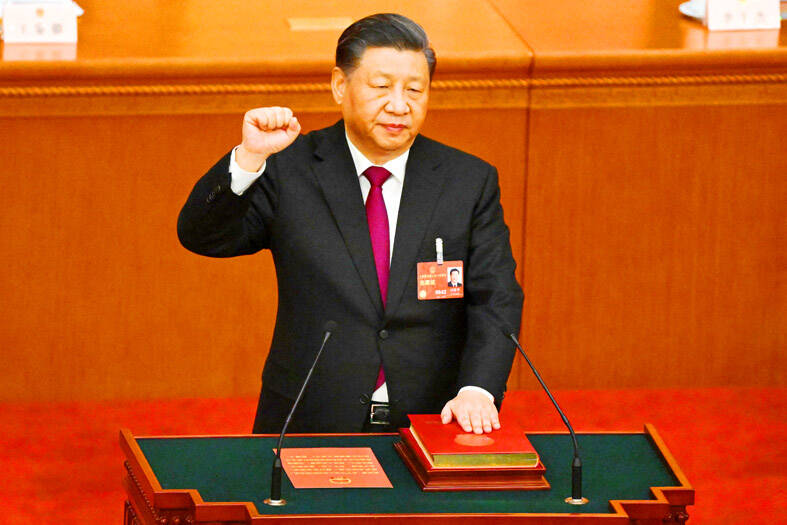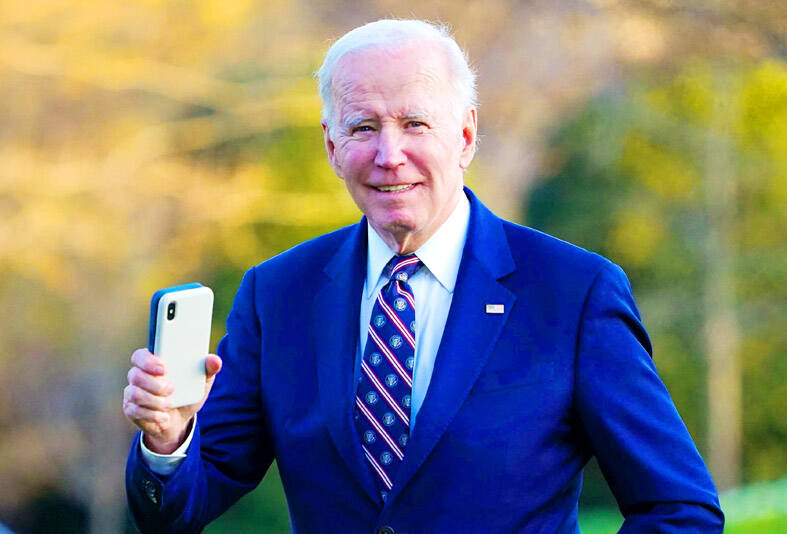China and the US have locked themselves into a new cycle of recriminations, provoking fresh worries that the world’s two biggest economies are heading down a path that could lead to open conflict.
The latest back-and-forth started on Monday, when Chinese President Xi Jinping (習近平) said in a speech that China was the victim of “comprehensive containment and suppression by Western countries led by the US.”
Two days later, US Director of National Intelligence Avril Haines called Xi’s remarks “the most public and direct criticism that we’ve seen from him to date” — and she responded in kind.

Photo: AFP
The Chinese Communist Party “represents both the leading and most consequential threat to US national security and leadership globally,” Haines told a US Senate hearing that covered everything from dangers posed by Chinese-owned TikTok to the threat of a US-China war over Taiwan.
The narratives brought into sharp focus how the US and China increasingly have one thing in common: a growing distrust of the other side. Even worse, the escalating rhetoric is entrenching divisions that could make it harder for both sides to find a way to coexist peacefully over the long term.
“The US-China relationship is stuck in a negative feedback loop,” said Jacob Stokes, a senior fellow at the Center for a New American Security. “It’s a volatile situation.”

Photo: AFP
Haines and CIA Director William Burns on Thursday said that the US intelligence community assesses that China does not want a military conflict over Taiwan, particularly after seeing the US and allied support for Ukraine after Russia’s invasion.
The countries remain each other’s top trading partners and both sides have insisted they do not want a new Cold War.
Still, each side is now accelerating preparations for that very scenario.
Xi this week implored his government to prepare for greater self-reliance, especially in science and technology, while the US is pushing its allies to reorient supply chains to deny China advanced chips and other strategic goods.
While pessimism around US-China ties is nothing new, relations have deteriorated at an alarming speed since US President Joe Biden met Xi in November last year and pledged to improve ties.
A national uproar over an alleged Chinese spy balloon that traversed the US fanned tensions and US Secretary of State Antony Blinken canceled a trip to Beijing meant to build upon the Biden-Xi summit.
After the US military shot down the balloon, a response that China called “hysterical,” Biden said he expected to soon be speaking with Xi.
Yet nearly a month later, the two leaders have not spoken.
Privately, Chinese officials say their attempts to extend a hand to Washington have been consistently slapped away.
One Chinese official said that the US speaks publicly about improving ties with China, but seeks confrontation in practice.
Another said that the countries are caught in a downward spiral that neither side knows how to stop.
Gao Zhikai (高志凱), a former Chinese diplomat who served as translator to former Chinese leader Deng Xiaoping (鄧小平), said Beijing believes that “China has been on the defensive side and the US has been on the aggressive side,” pointing to Washington’s evolving Taiwan policy and what he characterized as its efforts to “prevent China’s development by bashing its kneecaps.”
US officials, for their part, say that China still has not changed any of the behavior that has drawn criticism, from assertiveness toward its neighbors to its efforts to steal the intellectual property of US companies and harass dissidents overseas.
The tone taken by Chinese diplomats and state media have also made it more difficult to improve ties, they say.
This week alone produced a series of actions from the US Congress and the Biden administration that are likely to make it even more difficult to mend fences.
On Wednesday, US House of Representatives Speaker Kevin McCarthy confirmed plans to meet with President Tsai Ing-wen (蔡英文) in the US this year and has refused to rule out a trip to the nation.
The next day the Biden administration announced a budget proposal that included billions of dollars in requests to boost its military presence in Asia. The US even plans to sell nuclear-powered submarines to Australia.
“If the United States does not hit the brakes, but continues to speed down the wrong path, no amount of guardrails can prevent derailing and there will surely be conflict and confrontation,” Chinese Minister of Foreign Affairs Qin Gang (秦剛) said at the annual gathering of China’s National People’s Congress on Monday.
He ended with a glimmer of hope, saying China would still pursue a “sound and stable” US relationship.
“China’s overreach has triggered an extreme American overreaction,” said Susan Shirk, a former deputy assistant secretary of state for China.
“The war of words reminds me of the polemics during the US-
Soviet Cold War that made it almost impossible for us to think sensibly about the trade-offs between the costs and benefits of our own policies, or pursue diplomacy with the other side without being pilloried for being weak or unpatriotic,” she said.

Former Nicaraguan president Violeta Chamorro, who brought peace to Nicaragua after years of war and was the first woman elected president in the Americas, died on Saturday at the age of 95, her family said. Chamorro, who ruled the poor Central American country from 1990 to 1997, “died in peace, surrounded by the affection and love of her children,” said a statement issued by her four children. As president, Chamorro ended a civil war that had raged for much of the 1980s as US-backed rebels known as the “Contras” fought the leftist Sandinista government. That conflict made Nicaragua one of

COMPETITION: The US and Russia make up about 90 percent of the world stockpile and are adding new versions, while China’s nuclear force is steadily rising, SIPRI said Most of the world’s nuclear-armed states continued to modernize their arsenals last year, setting the stage for a new nuclear arms race, the Stockholm International Peace Research Institute (SIPRI) said yesterday. Nuclear powers including the US and Russia — which account for about 90 percent of the world’s stockpile — had spent time last year “upgrading existing weapons and adding newer versions,” researchers said. Since the end of the Cold War, old warheads have generally been dismantled quicker than new ones have been deployed, resulting in a decrease in the overall number of warheads. However, SIPRI said that the trend was likely

Indonesia’s Mount Lewotobi Laki-Laki yesterday erupted again with giant ash and smoke plumes after forcing evacuations of villages and flight cancelations, including to and from the resort island of Bali. Several eruptions sent ash up to 5km into the sky on Tuesday evening to yesterday afternoon. An eruption on Tuesday afternoon sent thick, gray clouds 10km into the sky that expanded into a mushroom-shaped ash cloud visible as much as 150km kilometers away. The eruption alert was raised on Tuesday to the highest level and the danger zone where people are recommended to leave was expanded to 8km from the crater. Officers also

BOMBARDMENT: Moscow sent more than 440 drones and 32 missiles, Volodymyr Zelenskiy said, in ‘one of the most terrifying strikes’ on the capital in recent months A nighttime Russian missile and drone bombardment of Ukraine killed at least 15 people and injured 116 while they slept in their homes, local officials said yesterday, with the main barrage centering on the capital, Kyiv. Kyiv City Military Administration head Tymur Tkachenko said 14 people were killed and 99 were injured as explosions echoed across the city for hours during the night. The bombardment demolished a nine-story residential building, destroying dozens of apartments. Emergency workers were at the scene to rescue people from under the rubble. Russia flung more than 440 drones and 32 missiles at Ukraine, Ukrainian President Volodymyr Zelenskiy